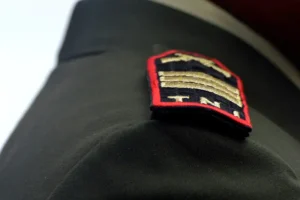 Epaulettes are more than just decorative elements on a uniform. They represent identity, authority, and tradition across military, police, and various uniformed professions. This article explores the history, types, design elements, and real-world applications of epaulettes, while also providing insights into how modern embroidery manufacturing supports high-quality epaulette production.
Epaulettes are more than just decorative elements on a uniform. They represent identity, authority, and tradition across military, police, and various uniformed professions. This article explores the history, types, design elements, and real-world applications of epaulettes, while also providing insights into how modern embroidery manufacturing supports high-quality epaulette production.
What Are Epaulettes?
Epaulettes are ornamental shoulder pieces used in military and police uniforms to signify rank, role, or affiliation. Historically, they originated in European armies during the 17th–18th centuries as practical devices to prevent shoulder straps from slipping, later evolving into formal symbols of authority.
Today, epaulettes serve as:
- Rank indicators in military and police forces.
- Identification elements in schools, fire departments, and security services.
- Ceremonial decorations for parades, official events, and uniforms of honor.
Types and Functions of Epaulettes
Different uniforms require different styles of epaulettes. They can be classified by material, purpose, and method of attachment.
Common Epaulette Categories
| Type | Description | Typical Usage |
|---|---|---|
| Cloth / Embroidered Epaulettes | Made of fabric, often with detailed embroidery | Military, police, school uniforms |
| Metallic Epaulettes | Incorporate metal threads, fringes, or ornaments | Ceremonial uniforms, high-ranking officers |
| Slip-On Epaulettes | Easily attach to shoulder straps, removable | Police, security, airline staff |
| Patch-Style Epaulettes | Produced as embroidered patches with Velcro or sewing options | Multi-purpose, customizable |
Functions
- Rank Identification – distinguishing officers, NCOs, or cadets.
- Unit/Branch Distinction – identifying divisions (army, navy, air force, police).
- Ceremonial Symbolism – adding prestige during parades and events.
- Corporate/School Branding – applied to private security, airlines, or academic uniforms.
Key Elements in Epaulette Design
Designing epaulettes requires both functional clarity and aesthetic precision.
1. Color and Material
Colors often symbolize branch or authority. For example, gold signifies ceremonial prestige, while subdued dark tones are used in tactical or police uniforms.
2. Embroidery Density and Thread Count
High-density embroidery provides sharper images and durability. Manufacturers with advanced machinery (e.g., 15-color Tajima machines) can create detailed insignia, gradients, and complex symbols.
3. Size and Shape
Epaulettes may be rectangular, rounded, or ornamental with fringes, depending on the uniform style.
4. Attachment Method
- Velcro for quick replacement.
- Heat-seal backing for easy iron-on.
- Sew-on edges for permanent application.
5. Branding and Modern Applications
Beyond military and police, epaulettes now extend into fashion and streetwear, becoming collectible design elements that emphasize identity and style.
Military & Police Uniform Applications
Epaulettes remain one of the most recognizable identifiers in armed forces and law enforcement agencies.
| Uniform Category | Epaulette Role | Example |
|---|---|---|
| Army | Rank insignia, regiment identification | Stars, bars, embroidered crests |
| Navy | Officer ranks, ceremonial dress | Gold stripes, anchor motifs |
| Air Force | Pilot wings, officer ranks | Embroidered wings, stripes |
| Police | Rank and division recognition | Sergeant stripes, shield logos |
| Firefighters & Emergency Units | Identity and command roles | Department-specific embroidery |
Epaulettes not only convey rank and order but also ensure quick visual recognition in high-pressure environments.
Case Studies
1. Military Example
In many European armies, ceremonial epaulettes with golden fringes are worn only on formal occasions, while simplified embroidered versions are used daily. This dual-use system balances tradition with practicality.
2. Police Example
Modern police forces often adopt slip-on epaulettes embroidered with rank insignia. These are lightweight, durable, and easy to replace, aligning with operational efficiency.
3. Manufacturing Example (Embroidery Focus)
At professional embroidery factories in Taiwan, production involves:
- Digitizing artwork → ensuring accuracy of logos and insignia.
- Sampling (3–5 days turnaround) → quick prototypes for approval.
- Embroidery on Tajima machines → supporting up to 15 colors for detailed results.
- Finishing → laser-cut edges, Velcro backing, or iron-on adhesive.
- Quality control → ensuring precision, durability, and uniform consistency.
This workflow supports both large-scale military orders and small MOQ custom requests for fashion brands or corporate clients.
Conclusion
Epaulettes are more than shoulder ornaments — they are a blend of heritage, identity, and design precision. From military officers to police departments and even modern fashion designers, epaulettes remain an essential element of uniforms worldwide.
For organizations looking to customize epaulettes with embroidery, partnering with experienced manufacturers ensures:
- High-definition embroidery with advanced machinery.
- Flexible order sizes for both small and large projects.
- Quick sampling and delivery to meet strict uniform schedules.
Epaulettes will continue to evolve, bridging tradition with innovation, while embroidery technology makes it possible to maintain detail, durability, and design excellence.